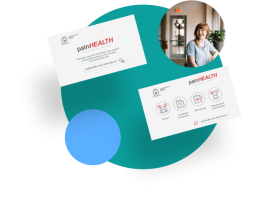Making sense of pain
Learn how to make sense of pain and how to manage your pain
Last updated: 28 Oct 2023 · 8 min read
Pain is complex. Pain is difficult to explain. Pain is confusing as “hurt” (or pain), does not necessarily mean harm. Pain isn’t visible: it can’t be seen on X-rays, scans or blood tests. This can make it hard for you to communicate with others about your experience of pain. It can also make it hard for others to understand what you are going through. To understand pain better, we need to be able to ‘make sense of pain’.
Making sense of xrays, imaging and pain
Imaging (such as xrays, MRI or CT scans, ultrasounds) frequently show changes in our tissues, bones, muscles and, ligaments. When pain is persistent, these changes do not always match up with a person’s pain experience. It is important to remember that pain is always real, even when there is no clear tissue injury or damage.
Tissue changes shown on imaging are often normal age-related changes and do not reflect tissue damage. This is why scans and xrays can show findings like disc bulges, arthritic changes or tendon degradation in people who are not experiencing pain. Ask your health professional ‘are these changes normal age-related changes?’.
Why does pain keep changing?
Pain can be changeable from moment to moment, hour to hour or day to day. Many factors interact to influence pain experience including our emotions, fears (fear of damage and avoidance/overdoing of activity, not feeling safe), low levels of physical activity, our beliefs about pain (it is not safe to move), distress, anxiety, depression, hopelessness and a sense of loss of control and social isolation are all factors that can negatively impact our pain experience. Other factors such as resilience, good support from family, employers and significant others can be protective and help us to better manage our pain.
Pain variations are puzzling: people can have a small amount of damage (e.g. paper cut) and a lot of pain, or lots of damage with a low level pain (e.g. soldiers in battle often state low pain levels after major injury as they are in survival mode). These pain variations are normal allowing us to adapt to pain depending on context. Pain can change even without an increase in tissue damage. For example, if you sit for too long in one position, your low back pain can increase, even though there is no extra tissue damage. Such pain variations relate to a feature of our systems known as neuroplasticity.
This mismatch between pain levels and tissue damage is well known. It can be reassuring for you to know this information and understand that these fluctuations may reflect the interaction of many factors at any point in time, but typically do not indicate more tissue damage.
Pain duration
The words acute pain and chronic pain refer to the time since the pain started – not the pain level. Acute pain is defined as less than three months. Chronic pain, or persistent pain, is usually defined as pain which lasts longer than the accepted tissue healing time: usually three months or longer.
Acute pain is usually thought of as related to local issue inflammation, infection or injury, whilst chronic pain often reflects a broader (systemic or whole person) issue. In acute pain, the ‘receptors’ (called nociceptors) tend to be local to the injury site. For example, if you sprain your ankle, the pain is felt at the ankle and the local tissues are sensitised.
In chronic or persistent pain, we see growing involvement from a number of body systems including the central nervous system, the immune and endocrine systems.
Taking a holistic approach to pain care
It makes sense that pain treatments for people living with chronic or persistent pain must address broader immune, nervous, hormonal, behavioural (our habits) and emotional contributors. To ‘make sense of pain’ all these factors should be considered part of a bigger picture: you may need help to manage your pain from a number of different health professionals and you may need different treatments (multimodal). Some ‘acute pain’ conditions can be complex, and therefore, may also need this broader approach to pain management.
The jigsaw of pain management
Dealing with ongoing pain is a bit like a jigsaw puzzle. For most people, there are at least six main pieces (or more) of the jigsaw puzzle. Importantly, medications are only one piece. Other pieces of the jigsaw include pacing and goal setting, meditation and relaxation, movement and exercise including simple stretches and a daily walk. Our pain management modules take you through each of these areas and help you to put together the pieces of the jigsaw that are best for you. You may also find this brochure helpful.
Another piece of the jigsaw is called ‘Pain Approach‘: accepting pain whilst reducing the associated fear and anxiety or low mood, reduces the struggle and energy spent on pain. Accepting pain does not mean losing hope! You can see an example of a pain jigsaw below.
Helpful insights
- if you have persistent pain, you “do better” in terms of your quality of life, when you use appropriate pieces of the pain management jigsaw. This means using a range of active pain management strategies
- pain is one signal that humans recognise as an “alarm” signal, which in acute pain is often an indication of injury or illness. For example, an acute muscle ‘strain’, ankle sprain or appendicitis
- while chronic or persistent pain may indicate harm (or damage) initially, as pain continues it is often not possible to pin-point why the pain is continuing or a single location or tissue responsible for the pain
- a key contributor to persistent pain is due to the adaptability of the nervous system: this is known as ‘neuroplasticity‘. Here, the change results in less and less movement, touch, temperature change or activities required to trigger pain.
- remember: the actions of nerves and immune cells can’t be seen on Xrays or CT, MRI or bone scans, or even blood tests
Download our postcard
We've just created a postcard PDF you can download to share with your patients easily.
Further information
For more information about making sense of pain, see our page about neuroplasticity. Alternatively, if you need to speak to your GP or health care professional, please seek further assistance.
Using a pain team
Neuroplasticity
Understanding pain: Brainman chooses
Getting a grip on pain and the brain
My cuppa jo - Making sense of pain through science and stories.
Pain: Considering complementary approaches eBook
- Bunzli S, Smith A, Schutze R, Lin I, O’Sullivan P. Making Sense of Low Back Pain and Pain-Related Fear. J Orthop Sports Phys Ther 2017; 47(9): 628-36. [PubMed]
This module has been developed by Professor Helen Slater, PhD, FACP, School of Physiotherapy and Exercise Science, Curtin University, Perth, Australia and Adjunct Associate Professor Stephanie Davies, MBBS, FANZCA, FFPMANZCA, Pain Medicine Specialist, WA Specialist Pain Services, Perth, Australia. The information in this module is based on current best evidence research and clinical practice.
SHARE THIS ARTICLE
Pain management information, stories and tips accessible anywhere, anytime.
Access clinically supported practical musculoskeletal pain management information to help you understand pain, how you can manage your pain with your management team on the go on any device.

